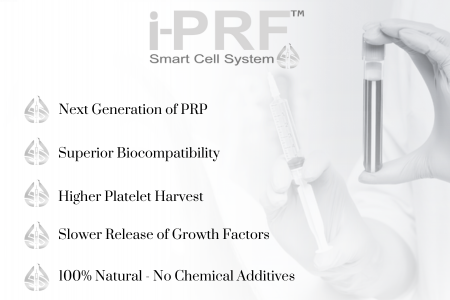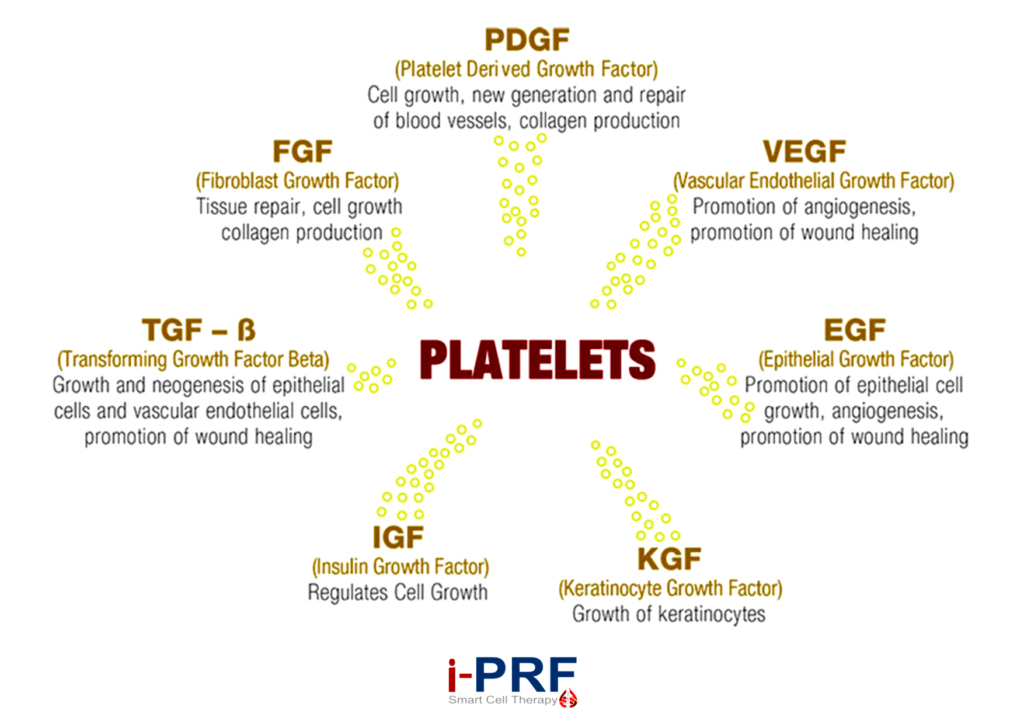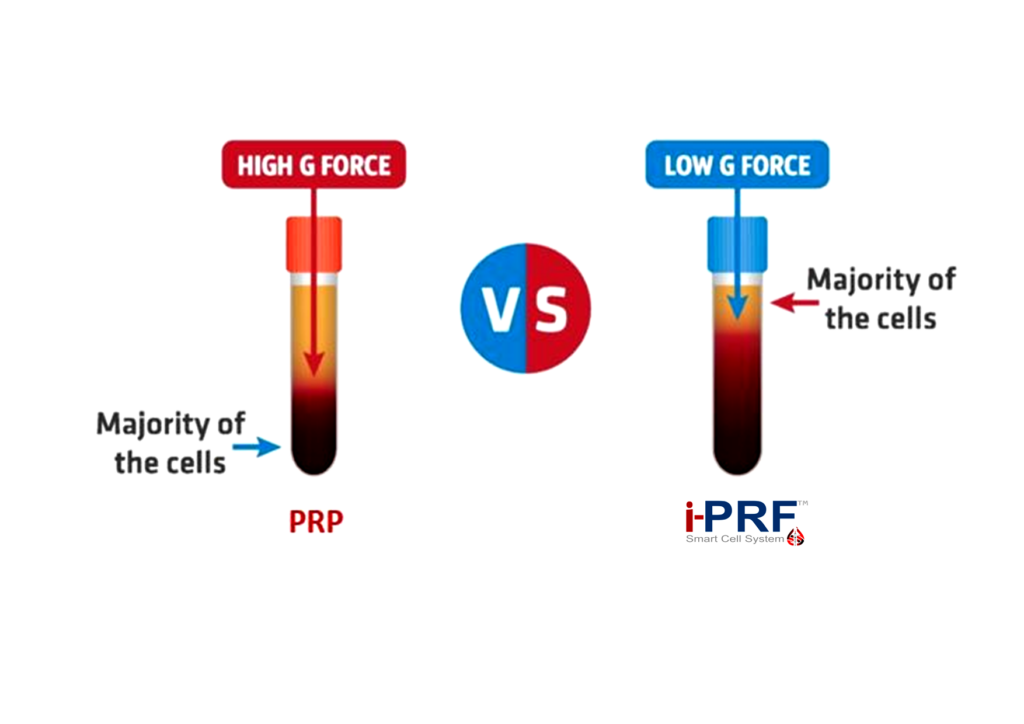If you’re experiencing hair thinning at the crown, temples, or across your scalp, our i-PRF (Injectable Platelet-Rich Fibrin) treatment at Rock Health Clinic offers a next-generation, minimally invasive alternative to surgery. Based in Birmingham city centre, our pharmacist-led regenerative clinic uses your own blood platelets and fibrin matrix to stimulate dormant hair follicles, boost hair density and restore stronger, healthier strands. With i-PRF, you’re choosing a scientifically advanced hair restoration option that combines medical expertise, tailored plans and comfort — helping you regain confidence and fuller hair with less downtime.

What is i-PRF?
i-PRF (Platelet-Rich Fibrin) treatment is a cutting-edge advancement following PRP (Platelet-Rich Plasma) therapy.
While similar to PRP, PRF stands out because it doesn’t use anticoagulants or chemicals, making it more effective. PRF contains up to 10x more platelets and releases growth hormones gradually over time. This thick, gel-like substance continues to stimulate hair follicles and promote hair growth long after treatment, unlike PRP which releases hormones more quickly.
PRF is a non-surgical, minimally invasive procedure that not only stimulates hair growth but also improves hair density and strength. It’s a promising solution for anyone experiencing hair thinning or loss, regardless of gender.
How Does PRF Work for Hair Loss?
The PRF treatment process begins similarly to PRP. A small amount of blood is drawn from the patient and then undergoes specialized centrifugation. This process separates the platelets and growth factors from other blood components, resulting in a PRF solution rich in essential bioactive proteins for hair growth and reducing hair fallout.
The key difference between PRF and PRP is the absence of chemicals and anticoagulants in PRF. This allows the plasma to form a fibrin scaffold rich in platelets and white blood cells when introduced into the scalp. This fibrin clot enhances cell adhesion and gradually releases growth factors over an extended period, making PRF more effective than PRP.
Experience the innovative PRF treatment for long-lasting, natural hair regrowth and improved hair density.

What Growth Factors are in i-PRF?
The PRF substance is packed full of growth factors, which are essential proteins that play a crucial role in the body’s healing processes. The growth factors in PRF include:
Basic Fibroblast Growth Factor (bFGF):
Known for stimulating cell growth, bFGF plays a significant role in tissue regeneration and wound healing. It supports the growth of new blood vessels and aids in the repair of damaged tissues.
Platelet-Derived Growth Factor-BB (PDGF-BB):
This growth factor is important for cell division, promoting the growth of connective tissues, blood vessels, and cell migration to the treatment site, significantly contributing to tissue repair.
Transforming Growth Factor β-1 (TGF-β1):
TGF-β1 is instrumental in regulating cell growth, production, and differentiation. It helps in the formation of new blood vessels and collagen, and is crucial for wound healing and tissue remodelling.
Insulin-like Growth Factor-1 (IGF-1):
Vital for cell growth and development, IGF-1 stimulates the production and differentiation of various cell types. It aids in tissue repair and regeneration.
Vascular Endothelial Growth Factor (VEGF):
VEGF also stimulates the formation of new blood vessels, improving blood supply to the treated area and supporting tissue healing.

How Does a PRF Facial Work?
i-PRF facial shares a starting point with our PRP Facial. A small blood sample is taken from the patient – giving reason for the name “Vampire Facial” – which then undergoes a specialised centrifugation process. By separating the platelets and growth factors from other components in the blood, the centrifuge creates a PRF solution that is highly rich in platelets and bioactive proteins essential for regenerating and revitalising the skin.
Similar to our PRF Hair Loss Treatment, our PRF treatment for face goes a step above PRP, as it does not involve the use of any anticoagulants or chemicals and uses up to 10x more platelets.
The absence of chemicals in PRF treatments means that the plasma is allowed to form a fibrin scaffold that is rich in platelets and white blood cells when introduced to the treatment area. This causes the gradual release of growth factors over time which help to sustain the results for longer, as opposed to PRP’s quicker release, which offers shorter term effects.

Benefits of i-PRF Therapy for Face
- Natural Rejuvenation
PRF facial treatments at promote natural skin rejuvenation without the use of any anticoagulants or chemical, harnessing the body’s own platelets and growth factors to stimulate collagen production for enhanced skin vitality and radiance.
- Long-Lasting Results
A slower and more sustained release of growth factors in PRF contributes creates much longer-lasting results compared to PRP, providing a continuous stimulation of collagen production for a lasting impact.
- Enhanced Cell Adhesion
The absence of chemicals allows the PRF plasma to form a platelet and white blood cell-rich fibrin scaffold, enhancing cell adhesion and optimising the effectiveness of the treatment.
- Minimal Downtime
Our PRF facial treatment is known for its minimal downtime, meaning you can get back to your daily activities as soon as possible.
PRF Treatment Frequently Asked Questions
PRF Treatment involves using the patient’s own blood to create a more advanced concentration of platelets and growth factors compared to PRP. PRF’s thicker consistency allows for a more sustained release of these healing elements.
How does PRF Treatment work, and what are its applications in various medical and aesthetic procedures?
PRF Treatment works by collecting and concentrating platelets, fibrin, and white blood cells from the patient’s blood. It is used in a variety of applications, including skin rejuvenation, hair restoration, and orthopedic procedures.
What makes i-PRF unique in terms of its consistency and release of growth factors?
PRF is unique due to its fibrin matrix, which gives it a gel-like consistency. This allows for a slower and more sustained release of growth factors, promoting longer-lasting therapeutic effects compared to traditional PRP.
Who is an ideal candidate for PRF Treatment, and how is eligibility determined?
Ideal candidates for PRF Treatment include individuals seeking skin rejuvenation, hair restoration, or orthopedic healing. Eligibility is often determined during a consultation and depends on individual health and treatment goals.
Can PRF Treatment be combined with other aesthetic or medical procedures for enhanced results?
Yes, PRF Treatment is often used in combination with other procedures, such as dermal fillers or surgical interventions, to enhance healing and promote better outcomes in both aesthetic and medical applications.
How many sessions of PRF Treatment are typically recommended to see optimal results?
The number of PRF sessions varies depending on the specific treatment goals and the individual’s response. In some cases, a series of sessions may be recommended for optimal results.
Is PRF Treatment painful, and is there any downtime associated with the procedure?
PRF Treatment is generally well-tolerated, and any discomfort is minimal. There may be mild swelling or bruising at the injection or treatment site, but downtime is typically short, allowing for a quick return to normal activities.
What is the expected timeline to see results after PRF Treatment for different applications?
Results from i-PRF Treatment can vary. For skin rejuvenation, improvements may be noticed within a few weeks, while hair restoration results may become apparent over a few months. Orthopedic healing timelines depend on the specific condition being treated.
Are there any potential side effects or risks associated with PRF Treatment?
i-PRF Treatment is generally considered safe, as it utilizes the patient’s own blood. Side effects are minimal and may include temporary swelling or bruising at the treatment site. Any specific concerns or conditions should be discussed during the consultation
Can PRF Treatment address specific orthopedic conditions, and what types of injuries can it assist in healing?
i-PRF Treatment is often used in orthopedics to aid in the healing of various injuries, including tendonitis, ligament injuries, and osteoarthritis. It promotes natural healing and tissue regeneration in these areas.
Difference between PRP and i-PRF:

Platelet-rich plasma
The platelet-rich plasma (PRP) consists of a high concentration of autologous platelets in a small amount of plasma following centrifugation of blood from the patient. These platelets present in the PRP release numerous substances that promote tissue repair and affect the behaviour of other cells.
Platelet-rich fibrin
Platelet-rich fibrin (PRF) is a more advanced platelet concentration and it is achieved with no biochemical manipulation of blood. This technique does not use anticoagulant. This feature makes the product easily usable, with a low rate of mistakes during the preparation stage. The fibrinogen is initially concentrated in the upper part of the tube but, upon the contact with thrombin, normally present in the blood, it is converted into fibrin. The platelets are retained within this fibrin, this is thought to release a higher amount of growth factors over a longer time period.

Why Choose i-PRF for Hair Loss in Birmingham?
Stronger results than conventional PRP — thanks to the fibrin matrix and longer growth factor release.
Non-surgical and minimally invasive — no incisions, low downtime, safe for both men and women.
Pharmacist-led clinic — ensures medical oversight, precision protocols and personalised treatment plans.
Tailored to your hair loss pattern — whether you’re dealing with receding hairline, thinning crown or post-transplant maintenance, we customise the plan.
Central Birmingham location with a clean, private clinic environment and straightforward access from across the West Midlands
What You Can Expect from i-PRF Hair Restoration
With a complete treatment course you can expect to:
See visible improvement in hair density and thickness.
Reduce the appearance of thinning patches and wideness in partings.
Strengthen existing hair and reduce excess shedding.
Experience a healthier scalp environment — often overlooked in hair loss strategies.
 Results vary depending on age, stage of hair loss, overall health and maintenance plan.
Results vary depending on age, stage of hair loss, overall health and maintenance plan.
 i-PRF is most effective when started at early-to-moderate thinning — advanced bald spots may need transplant support.
i-PRF is most effective when started at early-to-moderate thinning — advanced bald spots may need transplant support.
—
Are You a Good Candidate?
Who is Suitable for i-PRF & When It May Not Be Ideal
Good candidates:
Men and women in early to mid-stage hair thinning or pattern hair loss.
Individuals with visible miniaturised hairs (not smooth bald patches).
Post-hair transplant clients seeking enhanced growth.
Those wanting to avoid surgery and who can commit to a session plan.
When i-PRF may not be best:
Areas without any visible follicle activity.
Conditions like scarring alopecia, certain medical hair disorders or unaddressed hormonal causes.
Individuals unwilling to follow maintenance or lifestyle recommendations.
—
Treatment Plan & Aftercare
Your i-PRF Hair Regrowth Journey:
Typical plan: 3 sessions spaced 4–6 weeks apart, followed by maintenance treatments every 6–12 months.
Day of treatment:
Consultation & baseline photos.
Blood draw, i-PRF preparation.
Review of after-care and next session scheduling.
Aftercare guidance:
Avoid intense exercise, heavy sweating or saunas for 24 hrs.
Use gentle shampoos and avoid strong hair treatments for 48 hrs.
Protect scalp from sun; wear hats if outdoors.
Stay hydrated, eat a protein-rich diet, manage stress — your hair grows when your body supports it.
GET IN TOUCH
Schedule a Visit
Ready for Advanced Hair Regrowth? Book Your Free Consultation
Take the next step towards fuller, healthier hair at our Birmingham clinic.
 Call 07835 900 966 | Visit www.rockhealth.co.uk
Call 07835 900 966 | Visit www.rockhealth.co.uk
Spaces are limited—secure your appointment now and begin your journey with i-PRF.
Rock Health Clinic is a pharmacist-led, fully insured regenerative medicine clinic in Birmingham. Results vary between individuals. A full consultation is provided before any procedure.